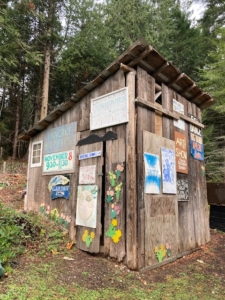 For as long as any of us can remember there has been an old wooden building located next to the Galiano Community Hall. It is a simple enough four-sided structure, thick wood boards nailed to unfinished posts rooted into the ground, sloping corrugated metal roof. A single door, no windows. The floor is made up of packed soil and one very old tree stump. One side of the structure seems to have been left open (to receive firewood?) and was eventually covered over with a number of reused wood doors. Originally built in 1931 as a “wood shed”, the structure has been used as a general storage shed since at least the late 1950s. Stage props, food stuffs, archival papers, garden tools, excess lumber, retired furniture, kitchen pots and pans, sandwich boards and much much more, all found temporary and even long-term storage there. In the last few decades the outer walls became a place to post old event signs (in the days when these were still made of wood with hand painted letters), signs that advertised a wide variety of Hall functions: dances, art shows, craft markets, etc. While the building probably served very well as a wood shed, it was never a satisfactory storage shed: drafty and uninsulated, rotting boards, rodent infested. Historic though the building was becoming, it has long been in need of replacement and relocating. Just this past month the Club Board decided to do both. Under the supervision of Club Director, Diana Burgoyne, the old building is being dismantled, the boards and poles saved for use elsewhere. (One of those helping with the dismantling is Barry New. Barry’s grandfather, Donald New, was one of the founders —- in 1924 —- of the Galiano Club and was most active with the Club in the early 1930s. Mr. New quite probably helped with the construction of the original shed, the very one that his grandson is now helping take apart.) A stronger, more efficient storage building is soon to be constructed closer to the Hall itself.
For as long as any of us can remember there has been an old wooden building located next to the Galiano Community Hall. It is a simple enough four-sided structure, thick wood boards nailed to unfinished posts rooted into the ground, sloping corrugated metal roof. A single door, no windows. The floor is made up of packed soil and one very old tree stump. One side of the structure seems to have been left open (to receive firewood?) and was eventually covered over with a number of reused wood doors. Originally built in 1931 as a “wood shed”, the structure has been used as a general storage shed since at least the late 1950s. Stage props, food stuffs, archival papers, garden tools, excess lumber, retired furniture, kitchen pots and pans, sandwich boards and much much more, all found temporary and even long-term storage there. In the last few decades the outer walls became a place to post old event signs (in the days when these were still made of wood with hand painted letters), signs that advertised a wide variety of Hall functions: dances, art shows, craft markets, etc. While the building probably served very well as a wood shed, it was never a satisfactory storage shed: drafty and uninsulated, rotting boards, rodent infested. Historic though the building was becoming, it has long been in need of replacement and relocating. Just this past month the Club Board decided to do both. Under the supervision of Club Director, Diana Burgoyne, the old building is being dismantled, the boards and poles saved for use elsewhere. (One of those helping with the dismantling is Barry New. Barry’s grandfather, Donald New, was one of the founders —- in 1924 —- of the Galiano Club and was most active with the Club in the early 1930s. Mr. New quite probably helped with the construction of the original shed, the very one that his grandson is now helping take apart.) A stronger, more efficient storage building is soon to be constructed closer to the Hall itself.
Construction of the Galiano Community Hall began in 1925 with an official opening four years later. The main room of the Hall, known as the Club Room, was initially unheated but in 1930 the Club purchased a single wood-burning stove for use there. The construction of a shed for the storage of fire wood was completed the following year. A janitor was hired whose duties included lighting a fire in this stove whenever heat was needed. (His 1931 end-of-year report stated that 158 fires had been lit!) A gas burning stove was installed in 1941 as “extra heat”.
Later that decade an “electric light plant” was placed in the Hall but it failed repeatedly.
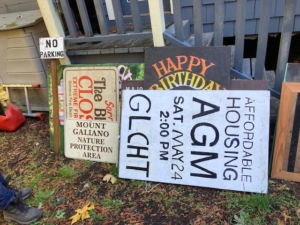 In 1949 a group of local entrepreneurs established the Galiano Light and Power Company. Initially the Company provided electrical power to some 30 customers in the Sturdies Bay area. In the early 1950s the Galiano Club agreed to invest in the Company with the arrangement including the bringing of electricity to the Hall. A single power line was eventually strung on wood poles (cut from the Bluffs) stretching from Sturdies Bay to the Hall. By the early 1960s, with the creation of both BC Hydro and BC Ferries, a more reliable supply to the island of both electrical power and of natural gas (originally named ‘rock gas’) eliminated the need, from the Hall, of all the oil lamps and of the wood burning stove, replacing them with electric lights, gas and electric heat. The need for a wood shed was no longer there.
In 1949 a group of local entrepreneurs established the Galiano Light and Power Company. Initially the Company provided electrical power to some 30 customers in the Sturdies Bay area. In the early 1950s the Galiano Club agreed to invest in the Company with the arrangement including the bringing of electricity to the Hall. A single power line was eventually strung on wood poles (cut from the Bluffs) stretching from Sturdies Bay to the Hall. By the early 1960s, with the creation of both BC Hydro and BC Ferries, a more reliable supply to the island of both electrical power and of natural gas (originally named ‘rock gas’) eliminated the need, from the Hall, of all the oil lamps and of the wood burning stove, replacing them with electric lights, gas and electric heat. The need for a wood shed was no longer there.
Though the shed itself will soon be gone, many of its elements will live on. Some of the one inch thick boards will be used as shelving in the new building. Some of the event signs, removed from the outer walls, are being stored for use in the Galiano Club’s upcoming (2024) 100th anniversary.
(Photos by Diana Burgoyne)
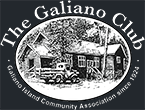
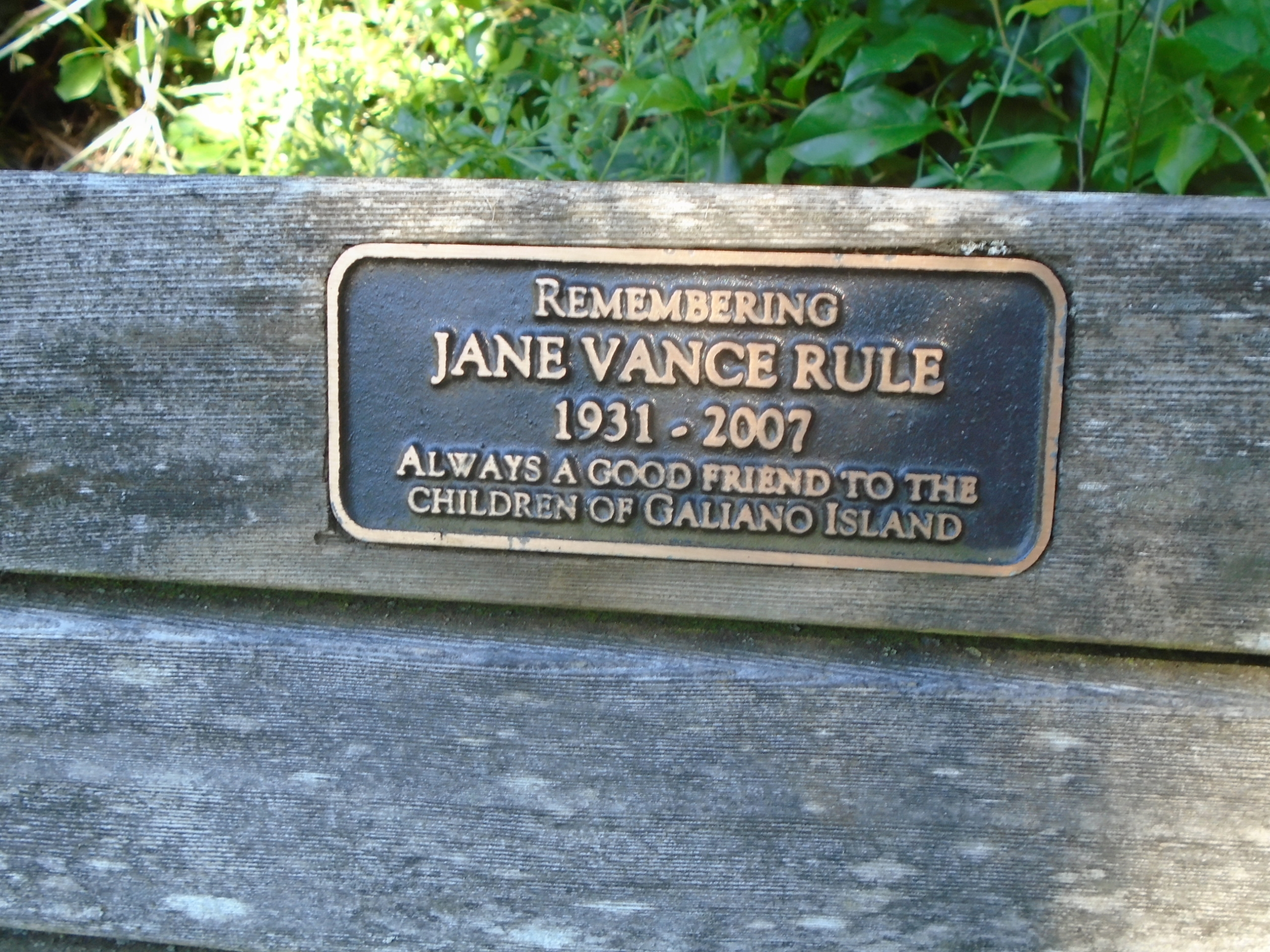

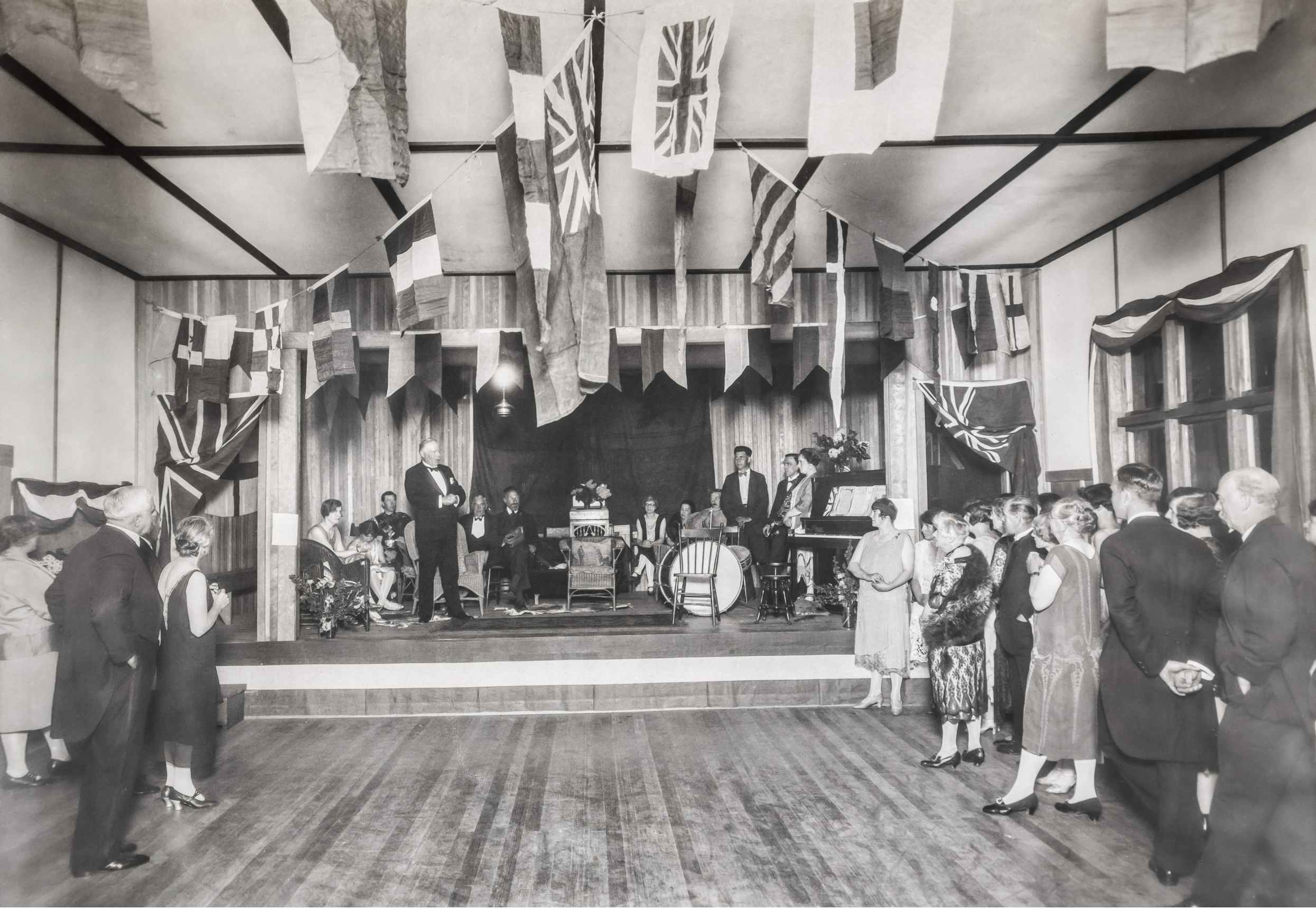
Leave A Comment
You must be logged in to post a comment.